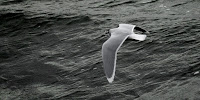LITTLE GULL
LITTLE GULL (Hydrocoloeus minutus) – (See images below)
DESCRIPTION: The Little Gull breeding adult has a black head, throat and upper neck. Lower neck, breast and under parts are white. Back and wings are light grey. Underwings are dark grey edged in white. Bill and eyes are black. In winter plumage the head is white with a grey smudgy crown and another grey smudge behind the eye. Wings are grey edged in white. First summer birds have a black ‘m’ pattern on wing tops, and the white tail is edged in black except for the tail central feathers. Juveniles have a darker wing pattern than first summer birds, and a black head cap. Tail white with black edge. Legs and webbed feet are red. Sexes are similar. Bird length is around 30 cm (12 inches). Smallest gull species.
VOICE: https://www.xeno-canto.org/species/Hydrocoloeus-minutus
NAME: ‘Gull’ would have its origins in Old Celtic ‘Gullan’ and other languages, including Latin ‘gula’ for throat. As per Choate this would be related to the gull’s ‘indiscriminate’ scavenging habits, its ‘willingness to swallow almost anything’ (think ‘gullible’). Latin genus name ‘Hydrocoloeus’ would mean a ‘type of web-footed bird’. Latin species name ‘minutus’ means the same as English ‘Little’.
HABITAT: Freshwater wetlands in the summer; coastal areas in the winter.
DIET: Insects (sometimes caught on the fly), also crustaceans, arthropods, worms, small fish.
NESTING: Nests in colonies near water. Nest is a shallow depression on the ground. Two to four green-beige eggs are laid, incubated by both parents. Chicks fed by both parents.
DISTRIBUTION: Breeds in northern Europe (except Norway and Sweden), and Asia. Winters along coasts of Europe, Mediterranean Sea, Black Sea, and Northern China. There is a small population that breeds sporadically in North America along the coasts of Hudson Bay and the Great Lakes, and winters along the east coast of the USA.
Distribution Map: https://en.wikipedia.org/wiki/Little_gull#/media/File:HydrocoloeusMinutusIUCNver2018_2.png
ON PEI: Does not breed on Prince Edward Island, sightings occasional or rare in summer or fall.
CONSERVATION: Population widespread, not currently considered at risk.
SIMILAR SPECIES: Bonaparte’s Gull, Black-headed Gull, Laughing Gull
REFERENCES: https://www.borealbirds.org/bird/little-gull
http://fieldguide.mt.gov/speciesDetail.aspx?elcode=ABNNM03030 (Montana Field Guide)
http://www.luontoportti.com/suomi/en/linnut/little-gull (Nature Gate Finland)
https://en.wikipedia.org/wiki/Little_gull
https://www.allaboutbirds.org/guide/Little_Gull/id
https://www.audubon.org/field-guide/bird/little-gull
https://identify.whatbird.com/obj/546/overview/Little_Gull.aspx
https://www.rspb.org.uk/birds-and-wildlife/wildlife-guides/bird-a-z/little-gull
http://www.oiseaux-birds.com/card-little-gull.html
DESCRIPTION: The Little Gull breeding adult has a black head, throat and upper neck. Lower neck, breast and under parts are white. Back and wings are light grey. Underwings are dark grey edged in white. Bill and eyes are black. In winter plumage the head is white with a grey smudgy crown and another grey smudge behind the eye. Wings are grey edged in white. First summer birds have a black ‘m’ pattern on wing tops, and the white tail is edged in black except for the tail central feathers. Juveniles have a darker wing pattern than first summer birds, and a black head cap. Tail white with black edge. Legs and webbed feet are red. Sexes are similar. Bird length is around 30 cm (12 inches). Smallest gull species.
VOICE: https://www.xeno-canto.org/species/Hydrocoloeus-minutus
NAME: ‘Gull’ would have its origins in Old Celtic ‘Gullan’ and other languages, including Latin ‘gula’ for throat. As per Choate this would be related to the gull’s ‘indiscriminate’ scavenging habits, its ‘willingness to swallow almost anything’ (think ‘gullible’). Latin genus name ‘Hydrocoloeus’ would mean a ‘type of web-footed bird’. Latin species name ‘minutus’ means the same as English ‘Little’.
HABITAT: Freshwater wetlands in the summer; coastal areas in the winter.
DIET: Insects (sometimes caught on the fly), also crustaceans, arthropods, worms, small fish.
NESTING: Nests in colonies near water. Nest is a shallow depression on the ground. Two to four green-beige eggs are laid, incubated by both parents. Chicks fed by both parents.
DISTRIBUTION: Breeds in northern Europe (except Norway and Sweden), and Asia. Winters along coasts of Europe, Mediterranean Sea, Black Sea, and Northern China. There is a small population that breeds sporadically in North America along the coasts of Hudson Bay and the Great Lakes, and winters along the east coast of the USA.
Distribution Map: https://en.wikipedia.org/wiki/Little_gull#/media/File:HydrocoloeusMinutusIUCNver2018_2.png
ON PEI: Does not breed on Prince Edward Island, sightings occasional or rare in summer or fall.
CONSERVATION: Population widespread, not currently considered at risk.
SIMILAR SPECIES: Bonaparte’s Gull, Black-headed Gull, Laughing Gull
REFERENCES: https://www.borealbirds.org/bird/little-gull
http://fieldguide.mt.gov/speciesDetail.aspx?elcode=ABNNM03030 (Montana Field Guide)
http://www.luontoportti.com/suomi/en/linnut/little-gull (Nature Gate Finland)
https://en.wikipedia.org/wiki/Little_gull
https://www.allaboutbirds.org/guide/Little_Gull/id
https://www.audubon.org/field-guide/bird/little-gull
https://identify.whatbird.com/obj/546/overview/Little_Gull.aspx
https://www.rspb.org.uk/birds-and-wildlife/wildlife-guides/bird-a-z/little-gull
http://www.oiseaux-birds.com/card-little-gull.html
 |
| Little gull breeding adult, Andrej Chudy |
 |
| Little gull breeding adult in flight, by Ekaterina Chernetsova, Russia |
 |
| Little gull juvenile, Finland, by Kallerna |
 |
| Little gull winter plumage, Jonn Leffmann |